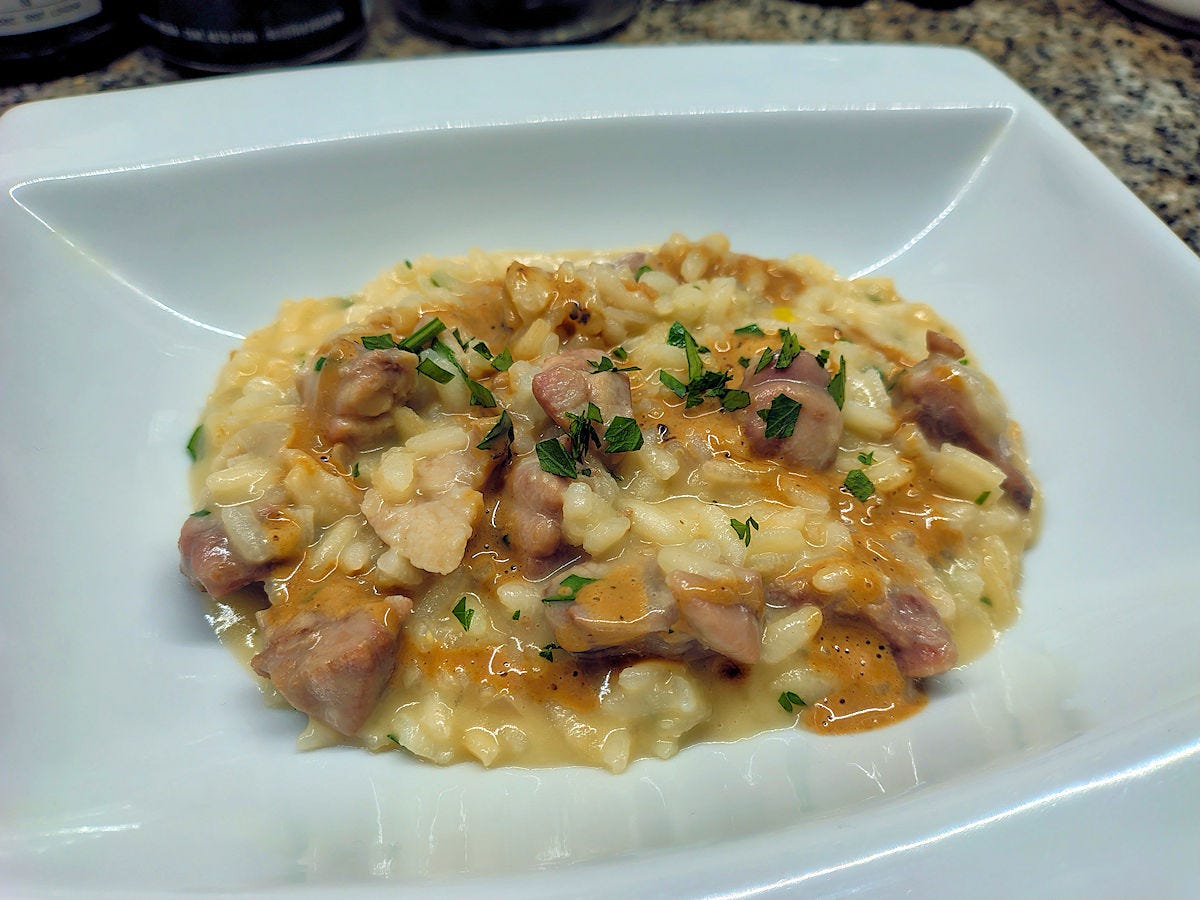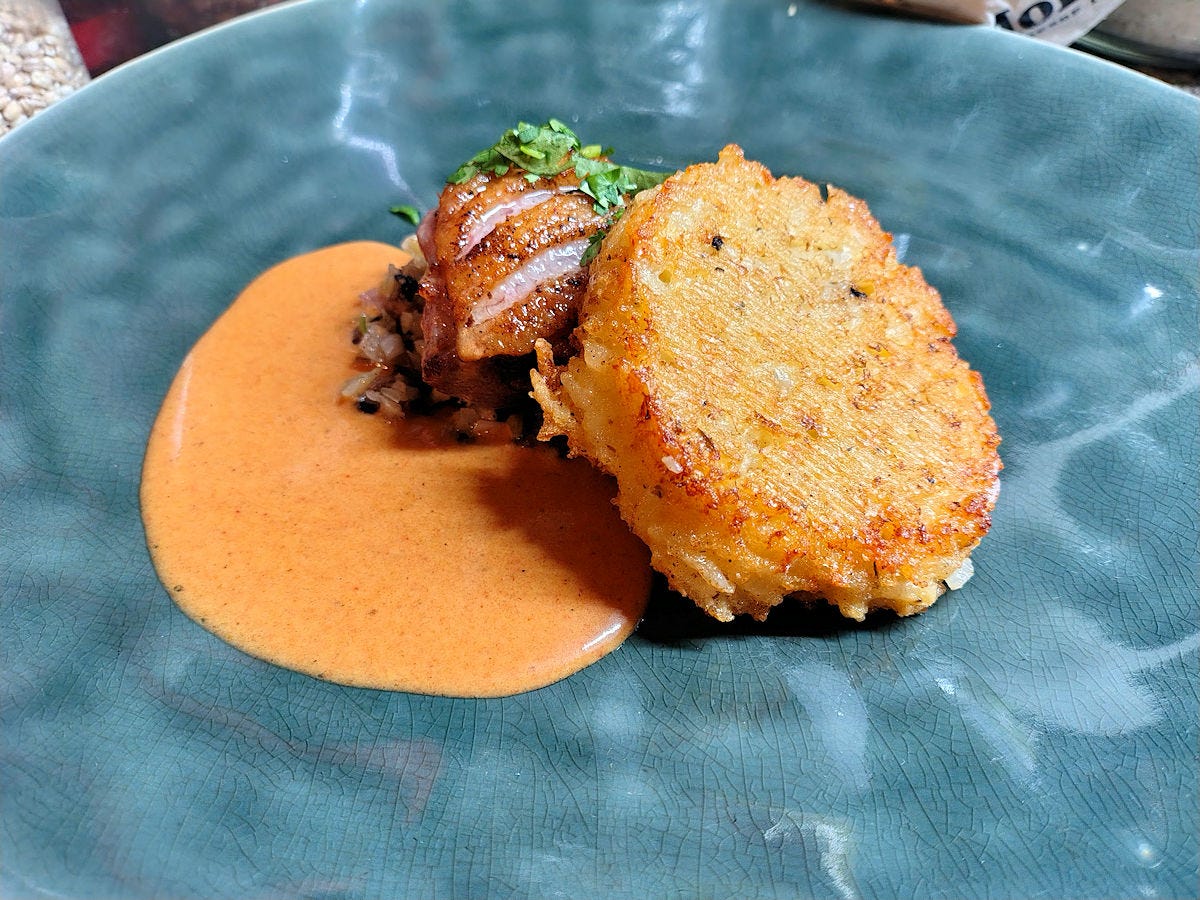The Late Summer Kitchen
“Summer cooking implies a sense of immediacy, a capacity to capture the essence of the fleeting moment.” - Elizabeth David, food writer
Here we are as the summer winds down. It seemed to go so fast. Only two and a half weeks until we’re in autumn here in Argentina. While I’m working on my various projects, I just thought to offer another round-up of some of the dishes that have graced the table here at Casa SaltShaker over January and February. Perhaps slightly more limited than usual, having spent three weeks in Lima.
Carrot Ginger Risotto with Prawn Tartare
Mosquita Muerta “Cordero con Piel de Lobo” Rosé 2024
We start by dry toasting Carnaroli rice in the oven until lightly golden. Then in a deep skillet, we sauté dry shrimp, finely minced aji amarillo (Peruvian yellow chili), and garlic in olive oil. Then we add the toasted rice and a splash of white wine to start the risotto process. We use a stock made from the prawn shells and carrot peelings to flavor the rice as it cooks. Separately, we’ve prepared a puree of roasted carrots and ginger. As the risotto nears completion, we stir in that puree, some butter, and a couple of egg yolks. Atop, a tartare of prawns mixed with Szechuan peppercorn oil, mirin, fish sauce, lemon zest, and chives. A few more chives for decoration as well. The wine is a 100% Malbec rosé from one of my favorite boutique wineries in Mendoza.
Sweetbread Risotto
Concha y Toro “Casillero del Diablo” Rosé Reserva 2023
And another risotto. Again, we start by oven toasting the Carnaroli rice. The risotto is begun with minced shallots and garlic, then the rice, a splash of white wine, and then a light veal stock to cook it. It’s finished with butter and stracciatella cheese. Separately, we prepare the sweetbreads, traditionally poached and then cooled, skinned, and diced. To serve, they’re sautéed in butter with shallots and garlic, and finished with a splash of our homemade green olive liqueur. Those are added to the risotto at the end, and then the whole thing is drizzled over with an espresso, black garlic, and coriander cream, and a final sprinkling of parsley. The wine is 100% Syrah rosé from the Central Valley of Chile.
Duck “Chepén Style”
Ruca Malen “Capítulo Dos” Petite Verdot 2022
There is a traditional duck dish in northern Perú from the small province of Chepén which is sort of a spicy version of duck a l’orange. How this particular combination of flavors arrived in northern Perú, in a province of only 71,000 people, with the largest town being half that size, I have no idea. Was it a local creation simply based on local produce, or was it influenced because, let’s imagine, some French chef settled down in Chepén at some point in history, and re-created the dish using local additions? Either way, I’ve only taken it as a starting point for our version of the dish.
The duck itself, a magret, or breast, scored, and dry rubbed with salt, pepper, and cumin and left to sit. For service, it’s sautéed in olive oil and butter, and sliced in half. The sauce is a pureed, strained, and emulsified blend of ají panca (dried Peruvian red chili), garlic, red onion, anchovy, cumin, oregano, black pepper, salt, orange juice and zest, anise liqueur. Underneath the duck breast is a little medley of sautéed red onion, fennel, green and black olives, and cilantro. The day before, we made a garlic and shallot risotto (January was, as I look back at things, a big risotto month). We let that cool, then mix in grated parmigiano and a whole egg. We press it into a round molds and chill it overnight. Then we griddle them with a little olive oil and butter to get a crispy exterior.
The wine is 100% Petite Verdot, one I’ve written about: “Deep purple color. Intense, jammy, boysenberry, with notes of cocoa, warm spices, and vanilla. Fruit forward, fairly full bodied, moderate acidity and alcohol, soft tannins, long finish.”
Calamarettes, Tomato Emulsion, Salsa Verde
De Moño Rojo M.R.V. 2024
Calamarettes, or chipirones, or, simply, baby squid. Lightly seared in olive oil - just a quick 15 seconds or so on each side. Then sprinkled with sea salt. Beneath them, a whisked together sauce of grated tomato, olive oil, and salt. Atop, a puree of basil, mint, garlic, green chili, lemon juice, and olive oil. And some crushed dried and fried corn kernels dusted with chili powder. The wine, from another small, boutique producer in the Uco Valley of Mendoza, is a blend of 45% Roussane, 45% Marsanne, and 10% Viognier, co-fermented in concrete eggs and left to mature for seven months before bottling.
Confit of Rabbit, “Ajiacco” Fondant Potato
Catena “Saint Felicien” Bonarda 2022
Another inspiration from a traditional dish. Those of you who’ve been with me for a long time may recall my decade-ago search for the best ajiacco de papas con conejo in the city. A dish that’s more or less disappeared from Peruvian restaurant menus these days and been replaced by a chicken version. Presumably an economic decision - rabbit has gotten quite scarce and pricey the last few years here, not sure why. The traditional dish is basically a creamy, spicy diced potato dish served with a side of stewed rabbit.
In our version, we confit the rabbit leg quarters in olive oil with red onion, garlic, thyme, oregano, and black peppercorns. We make a fondant potato - a thick slice of potato, lightly browned in olive oil and butter, then hot chicken stock is added to the pan, and the potato is cooked on low heat until tender. We make what amounts to a modified huancaina sauce, which I always refer back to when I first learned to make it from Henry’s sister Maria, in the family kitchen, eighteen years ago. Here, I soaked walnuts and soda crackers in milk to soften them up a bit, and then pureed that with fresh goat cheese and the softened, skinned and seeded ajíes amarillos. The potato is then drizzled with a black garlic oil, and the rabbit is topped with a quick salad of red onion slivers tossed with parsley, cilantro, mint, rice vinegar, and salt. The wine is 100% Bonarda from Mendoza.
Caramelized Fig Cheesecake
Zuccardi “Malamado” Viognier 2024
And, we’ll finish off this round-up with a dessert. The base is puff pastry. The filling is a ricotta cheesecake sweetened with brown sugar and flavored with vanilla and lemon. The figs are caramelized in butter and brown sugar and then nestled into the top of the cheesecake mixture. The whole thing is baked and then chilled. We served it topped with whipped cream sweetened with honey and studded with finely chopped pistachios and candied orange peel, and a pinch of sea salt. The wine is a late harvest Viognier from Mendoza.
For those who don’t follow us, or me, on other social media, we’re experimenting starting this month with a one day a week lunch at Casa SaltShaker. It will be, basically, a two-course meal, with an appetizer and main course - most of the time the main course is going to be a pasta, but we will mix that up. And then coffee and something sweet at the end - not a full dessert, but probably, based on whatever region of the world we’re exploring with the lunch, something cookie-ish. And, the idea is that we’ll be sitting down to lunch with our guests, be it one person or half a dozen, something we’re not able to do at the dinners. Details on our website!







